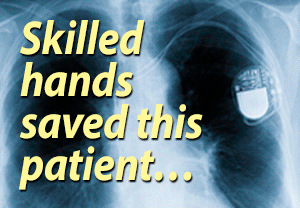 Test
Test
- by Happygirl8
- 2021-11-30 22:18:40
- Conditions, Meds & Tests
- 735 views
- 7 comments
Has anyone had a CT angiogram coronary test? They inject a dye, then get pictures if arteries in heart! Was it invasive?
7 Comments
CT Angiogram
by Gemita - 2021-12-01 04:44:06
Hello Happygirl,
I agree with AgentX86. A CT Angiogram is not invasive as is a coronary angiogram which is the gold standard for confirming coronary artery disease. Because of the invasiveness of the latter test, there usually has to be a strong indication of a problem through echo stress testing first (like worsening exercise tolerance, breathlessness, chest pain) before a coronary angiogram is carried out.
The problem with the non invasive CT Angiogram is that if a significant blockage is found, your surgeon would be unable to clear the blockage or to correct the problem with say a stent at the same time, so would still need to go in with the gold standard coronary angiogram. The latter procedure uses a long thin flexible tube called a catheter which is inserted into a blood vessel. Mine was inserted into my groin and the tip of the catheter is passed to the heart and coronary arteries giving your surgeon direct excellent views not only of blockages but also of the health of your arteries.
I would just like to warn that iodinated contrast used during Angiograms, especially if kidney function is poor may cause an allergic reaction, so they usually want to check kidney function with blood tests beforehand if kidney disease is present. My husband had a thyroid storm after his coronary angiogram and had to be hospitalised for a few days. Iodinated contrast could potentially further damage kidney function too, if disease is present. Please let your doctors know if you have ever had a serious reaction to the iodine contrast dye, so that they can keep you safe.
Coronary angiogram vs CTA
by AgentX86 - 2021-12-01 12:46:27
Just wanted to clarify what Gemita said, if anyone was confused. A "CT angiogram" or CTA uses dye and a CT scanner and can be used to "see" blockages in any part of the body. Other than injecting the dye, this is completely non-invasive.
A "coronary angiogram" is what we often call a "heart cath", as Gemita said, uses a "catheter" (long tube) to actually go into the arteries in the heart to see what's there. They also inject a dye into the arteries so they show up on a fluroscope better.
When I said that a CTA was the "gold standard" I meant that it's even better than an MRI, in this case. Of course actually going into the artery is even more reliable but more invasive. A stress test can also be used to asess the health of the heart but is less specific.
Gemita's heart cath entry point was the groin. My carotid cath entered in the "same" artery (femoral artery) and went up through the aorta, then took either the 'Y' in the road into either the right or left carotid artery. For a heart cath the catheter goes the other way in the 'Y' further up (over at this point) the Aorta and into the heart.
OTOH, my heart cath entered into the radial artery in the wrist, instead of the femoral in the groin. If you have a choice, take the wrist. Arteries are at a high pressure so it takes a while for them to close after the incision. In the case of the femoral artery, you're stuck laying flat on your back for several hours. I thought that was next to inbareable. I didn't know which hurt more, my back or my bladder.
OTOH, when the wrist is used, afterwards a pressure device is placed on your wrist, which looks like a wide, tight, bracelet and send you on your way. You wear this device for several hours, take it off, switch to a regular bandage for another several hours and it's all done. If you must have a heart cath this is highly recommended, if you can find a cardiologist trained to do it (few are, or at least were in 2014).
There is a chance that your radial artery isn't large enough or there is some other problem so they also prep to use the femoral artery, just in case.
But back to the CTA - piece of cake. It's just a little more complicated than a dental X-ray.
CTA
by Good Dog - 2021-12-05 20:50:35
Just a quick FYI; I recently had a CT veinogram and since I have a shellfish allergy the Doc ordered it using CO2 as a contrast agent instead of Iodine dye. My point is that there may be an alternative to the dye if your Doc and facility offer it. As the others stated, the test is a piece of cake! Quick and easy!
CT angiogram
by Happygirl8 - 2022-04-26 19:13:08
Before the CT angiogram did they give you any pulse lowering drugs? They told me my pulse needs to be under 60 to get clear pics, or they administer drugs to lower pulse! I have Bradycardia and pacemaker is set for 60, so I really don't want pulse lowering drugs ! They said instead of drugs, they will have a technician there from the pacemaker company to lower the pulse through the pacemaker for the test ! Has anyone heard of this?
CT angiogram
by Happygirl8 - 2022-04-26 19:14:09
Before the CT angiogram did they give you any pulse lowering drugs? They told me my pulse needs to be under 60 to get clear pics, or they administer drugs to lower pulse! I have Bradycardia and pacemaker is set for 60, so I really don't want pulse lowering drugs ! They said instead of drugs, they will have a technician there from the pacemaker company to lower the pulse through the pacemaker for the test ! Has anyone heard of this?
Happygirl8
by Gemita - 2022-04-27 05:08:14
This is what you finally told us in a recent post on the same subject and I quote:
"I called the cardiologist office and they are not concerned, so I guess I'll put it to rest! The nurse said I will be in good hands and they will monitor me throughout the test! She said the CT Angiogram is a test he prescribes often for his patients and no one ever had an issue! Thank you for your input".
The link to your recent thread is below:
https://www.pacemakerclub.com/message/41826
I thought you had been finally reassured?
If a pacemaker technician is present, he can adjust your pacemaker lower rate safely and quickly during CT Angiogram for clearer views rather than your doctors needing to prescribe rate lowering medication, so sounds even better to me. Having a technician present is not something that I have heard about for a straightforward CT Angiogram since many patients have CT Angiograms with low heart rates who do not have pacemakers. Perhaps they decided it was the only way they could reassure you to get the procedure done?
You know you're wired when...
You play MP3 files on your pacer.
Member Quotes
Try to concentrate on how youre able to be active again and feel normal, rather than on having a machine stuck in your body.




CTA
by AgentX86 - 2021-12-01 01:08:24
I had a CTA on my carotid arteries and a CT on my head (a couple of times). There is nothing to it. For the CTA, they inject the contrast die then sick you in the CT machine. A CT is nothing like an MRI. There is no chance of upsetting your PM so no special procedures are needed. There is no cramped, noisy, tube. You're in and out in a few minutes.
The one thing that I will say about a CTA is that, while it is the gold standard for non-invasive arterial imaging, it's often fools gold. My CTA showed that my carotid arteries were 70-80% blocked so the vascular surgeon went in to stent it (the other choice was to slice and dice my neck). When he got in with the catheter the arteries were, at most, 20% blocked. That's nothing at all so they just took everything out an had me flat on my back in the recovery room for five hours for nothing.
Don't worry. It really is nothing. You are radioactive for a while so an airport may be hazardous to your health for a day or so.